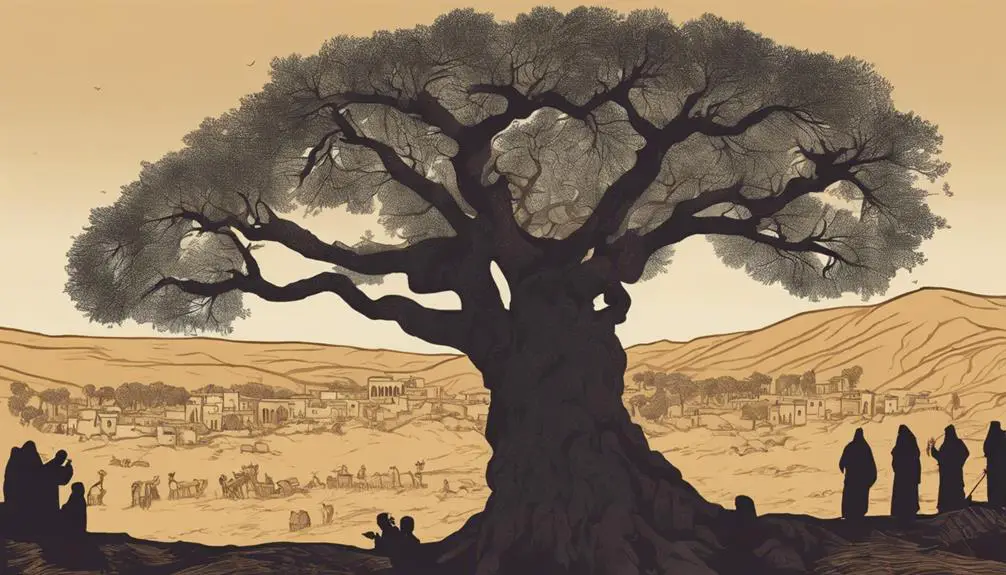Terebinth trees in the Bible symbolize resilience and history, inviting exploration of their deep-rooted significance in spiritual and ecological narratives.

What Is a Terebinth Tree in the Bible
Imagine walking through the arid landscapes of the Middle East, where the resilient terebinth tree stands tall against the backdrop of biblical history. You've likely skimmed over its mention in scripture, not pausing to consider its significance.
Yet, this tree weaves a rich tapestry of historical, spiritual, and ecological narratives that beckon for a closer look. Its roots run deep in the biblical text, offering shades of meaning well beyond its physical presence.
Let's explore the layers of symbolism and cultural importance that have elevated the terebinth from mere flora to a significant biblical emblem, inviting you to uncover its mysteries.
Key Takeaways
- The terebinth tree, or Pistacia terebinthus, is noted for its resilience and endurance in arid environments.
- It carries significant spiritual symbolism, representing growth, renewal, and divine connections in the Bible.
- Terebinth trees had practical uses in daily life and held cultural importance in ancient Near Eastern societies.
- Their ecological contributions include stabilizing soil, supporting biodiversity, and providing habitat for various wildlife, aligning with their symbolic representations of strength and healing.
Historical and Botanical Overview

In the historical and botanical landscape of the ancient Near East, the terebinth tree emerges as a significant species, deeply intertwined with cultural, religious, and ecological narratives. You'll find that this tree, known scientifically as Pistacia terebinthus, flourishes under specific growth conditions, favoring the sun-soaked, dry soils that typify the region's terrain. Its resilience in arid environments underscores not only its ecological importance but also its symbolic resilience in the face of adversity.
The terebinth's ability to thrive in such conditions speaks to its deep-rooted adaptability and hardiness. Its preference for calcareous soils, coupled with a notable tolerance for drought, makes it a quintessential component of the Near Eastern landscape. This adaptability isn't just a matter of ecological interest; it mirrors the enduring nature of the cultures that have historically coexisted with it.
Seed dispersal mechanisms of the terebinth further illustrate its integral role in the ecosystem. The tree's seeds are predominantly spread by birds and other wildlife, a natural process that ensures the propagation of this species across the diverse terrains of the Near East. This mode of seed dispersal not only facilitates the widespread distribution of the terebinth but also underscores the interconnectedness of flora and fauna within this ecological niche.
Through a detailed examination of its growth conditions and seed dispersal methods, you gain a deeper appreciation for the terebinth tree. Its botanical characteristics aren't merely factual data; they're a testament to the tree's resilience and its seamless integration into the fabric of the ancient Near East.
Spiritual Symbolism

Beyond its ecological significance, the terebinth tree embodies a wealth of spiritual symbolism, deeply rooted in the biblical narratives that have shaped countless generations. The resonance of this tree within the spiritual and religious context of the Bible is multifaceted, offering insights into the divine and the human condition.
To delve into its spiritual significance, consider these aspects:
- Endurance and Resilience: The terebinth tree, known for its longevity and ability to thrive in arid conditions, serves as a metaphor for spiritual endurance. Its steadfastness amidst the challenges of nature mirrors the faith required to withstand spiritual trials and tribulations.
- Growth and Renewal: Just as the terebinth regenerates from its stump, it symbolizes hope and renewal. This regenerative quality aligns with themes of resurrection and new life, offering a tangible representation of divine promises of restoration.
- Shelter and Refuge: The expansive canopy of the terebinth provides shelter and protection. This aspect of the tree mirrors the biblical promise of divine shelter for those who seek refuge in the spiritual realm, embodying a safe haven amidst life's storms.
- Sacred Spaces: Historically, the terebinth was often found in places considered sacred, facilitating divine connections. Its presence in these locales underscores the tree's role as a bridge between the earthly and the divine, serving as a backdrop for encounters with the sacred.
Through these tree metaphors, the terebinth transcends its botanical identity, weaving a rich tapestry of spiritual symbolism that invites deeper reflection on divine connections and the human journey.
Notable Biblical References

Several passages throughout the Bible highlight the terebinth tree's significance, reflecting its deep spiritual and historical resonance within the text. This resonance isn't merely anecdotal; it's intricately connected to the tree's geographical distribution and its perceived healing properties, which are subtly woven into the narrative fabric of the Scriptures.
The terebinth's geographical distribution across the Middle Eastern landscapes, particularly in regions chronicled within the Biblical narrative, underscores its ubiquity and the natural integration into the daily and spiritual lives of the people. This widespread presence isn't incidental; it's emblematic of the tree's resilience and its ability to thrive in arid climates, symbolizing spiritual endurance.
Moreover, the healing properties attributed to the terebinth, though not explicitly detailed in the Biblical text, are inferred through its repeated mentions in contexts of sanctity and blessing. Ancient understanding of flora often intertwined with medicinal knowledge, suggesting that the terebinth's presence might've represented not just physical but also spiritual healing, a sanctuary for the weary soul and a balm for the afflicted.
Analyzing these references, it's clear that the terebinth tree was more than just a physical landmark within the Biblical landscape. It served as a powerful metaphor for strength, resilience, healing, and sanctity, deeply embedded in the spiritual consciousness of the time. Its significance extends beyond the literal, offering insights into the cultural and spiritual fabric of the Biblical world, making it a subject of enduring fascination and scholarly interest.
Cultural Significance

Delving into the cultural significance of the terebinth tree, one can't overlook its profound impact on societal norms and spiritual practices within the Biblical era. The terebinth tree, with its extensive history and presence in biblical narratives, served not only as a physical landmark but also as a multifaceted symbol, enriching the cultural and spiritual life of the communities that held these stories dear.
Here are four pivotal ways the terebinth contributed to the cultural milieu:
- Symbolism in Religious Texts: The terebinth tree frequently appears in the Bible as a symbol of strength, longevity, and resilience. Its enduring nature made it a powerful metaphor for spiritual steadfastness, deeply influencing religious teachings and personal reflections of faith.
- Terebinth Uses in Daily Life: Beyond its symbolic significance, the terebinth tree had practical uses that were integral to daily living. Its oil was used for cooking and lighting, making it essential for household management and religious rituals. The tree's nuts and wood also played significant roles in nutrition and craftsmanship, respectively.
- Art Inspiration: The stately figure and profound symbolism of the terebinth tree inspired artists throughout the ages. Its depiction in religious and historical art served not only as a visual reminder of its cultural importance but also as a bridge connecting the spiritual and the mundane.
- Cultural Landmarks: Terebinth trees often marked important sites and were associated with memorable biblical events. These locations became pilgrimage sites, weaving the tree further into the cultural and spiritual identity of the people.
The terebinth tree's multifaceted contributions to societal norms, spiritual practices, and art inspiration within the Biblical era underscore its indelible mark on culture and history.
Ecological Impact

The ecological impact of the terebinth tree extends well beyond its obvious contributions to the landscape, playing a crucial role in both preserving biodiversity and supporting the surrounding ecosystem. You might not initially consider the depth of influence a single species can exert, but the terebinth tree's presence significantly mitigates soil erosion. It does so by stabilizing the soil with its extensive root system, which prevents the topsoil from being washed away during heavy rains. This not only preserves the immediate environment but also maintains the fertility of the land, ensuring that other plant species can thrive alongside it.
Moreover, the terebinth tree serves as a vital wildlife habitat. Its dense foliage offers shelter to a variety of birds and small mammals, creating a microhabitat where these species can nest and feed. This aspect of the terebinth's ecological impact is particularly crucial in regions where natural habitats are diminishing.
To help you appreciate the multifaceted ecological contributions of the terebinth tree, consider the following table:
Aspect |
Contribution |
Impact on Ecosystem |
|---|---|---|
Soil Stabilization |
Mitigates soil erosion |
Preserves land fertility |
Biodiversity Support |
Provides habitat for various species |
Enhances ecosystem stability |
Carbon Sequestration |
Absorbs CO2 from the atmosphere |
Contributes to climate mitigation |
Shade Provision |
Reduces ground temperature |
Supports understory growth |
Pollination |
Flowers attract pollinators |
Facilitates reproduction of plants |
Through these contributions, the terebinth tree illustrates the interconnectedness of ecological systems, highlighting how individual species play essential roles in sustaining environmental health and resilience.
Frequently Asked Questions
How Do You Properly Care for and Cultivate a Terebinth Tree in a Home Garden or Landscape Setting?
To properly care for a terebinth tree, you'll need to understand its specific soil requirements and watering frequency.
This tree thrives in well-drained soil, so ensure you're not overwatering; the soil should be moist but not soggy. Watering frequency should be adjusted based on the season, less during winter months.
Regularly check the soil's moisture level and adjust your watering schedule accordingly to promote healthy growth and avoid root rot.
What Are the Common Pests and Diseases That Affect Terebinth Trees, and How Can They Be Managed or Prevented?
You're tackling common pests and diseases in terebinth trees, crucial for their health.
Imagine you've noticed leaf discoloration. Through insect identification, you discover aphids are to blame.
Implementing disease control methods, such as introducing natural predators like ladybugs, can effectively manage this issue.
It's essential to monitor your tree regularly, applying both preventive and reactive strategies to ensure its well-being.
This analytical approach minimizes damage and maintains tree health.
Are There Any Modern Medicinal Uses or Health Benefits Associated With Terebinth Tree Products, Such as Its Resin or Leaves?
You're exploring the modern medicinal uses of terebinth tree products, such as its resin or leaves. In analyzing this, consider the historical context and cultural significance of these uses.
Research shows that terebinth resin and leaves have been applied in traditional medicine for centuries. Their anti-inflammatory and antimicrobial properties are particularly noted.
Today, these uses are backed by scientific studies, highlighting a bridge between ancient practices and contemporary health solutions.
How Does the Terebinth Tree Compare to Similar Species in Terms of Growth Rate, Longevity, and Overall Size?
You're exploring how the terebinth tree's growth rate, longevity, and size stand against similar species. Its growth and size reflect its tree symbolism and historical significance, showcasing resilience and strength.
Compared to peers, the terebinth grows moderately fast, lives long, and reaches a substantial size, embodying endurance. This analysis reveals the terebinth not just as a plant but as a symbol steeped in history, highlighting its unique presence in nature.
Can Terebinth Trees Be Used in Culinary Applications, and if So, What Are Some Traditional or Contemporary Recipes?
Yes, you can use terebinth trees in culinary applications, much like an artist uses a palette of colors. Its nuts offer unique flavor profiles, enriching dishes with a taste that's deeply rooted in tree symbolism, embodying strength and resilience.
From traditional Middle Eastern stews to contemporary vegan spreads, the terebinth's versatility shines. Delving into these recipes, you'll find its distinctive taste adds depth and complexity, elevating the culinary experience.
Conclusion
In your exploration of the terebinth tree within Biblical narratives, you've unearthed its multifaceted identity. This tree isn't merely a botanical figure; it embodies profound spiritual symbolism, marks significant Biblical events, influences cultural practices, and impacts ecological systems.
Your investigation confirms the theory that the terebinth's presence in scripture isn't accidental but intentional, reflecting its deep-rooted significance in ancient societies. Such an analytical journey underscores the intricate relationship between nature and spirituality, illustrating how even a single tree can hold a reservoir of cultural and ecological importance.



Sign up